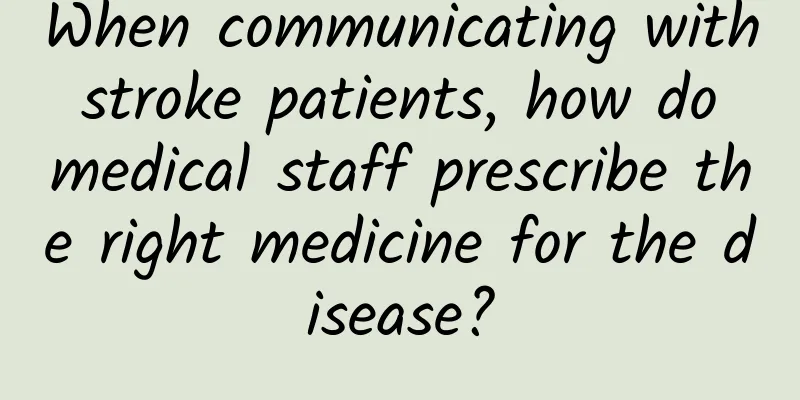When communicating with stroke patients, how do medical staff prescribe the right medicine for the disease?

|
This is the 4055th article of Da Yi Xiao Hu "Doctor, hurry! My father suddenly can't move half of his body and can't speak clearly." In the hospital, we often hear family members anxiously describe the situation to the doctor. "Crooked mouth and slanted eyes", "disordered movement of one limb", "indistinct speech", "asymmetric face" are all manifestations of cerebral apoplexy (commonly known as 'stroke'). How should medical staff communicate well with patients with special conditions such as cerebral apoplexy? Many people believe that cancer is the number one killer of Chinese people. However, the fact is that the number one cause of death in China is stroke, which has the characteristics of high incidence, high disability, high recurrence and high mortality. It has an acute onset, rapid progression and serious consequences, which brings a heavy burden to patients, their families and society. In 2011, the Stroke Prevention and Control Project Committee designated October 29th of each year as "World Stroke Day" and the launch day of China Stroke Prevention and Control Week. The Global Burden of Disease study published in 2021 showed that the incidence, prevalence and mortality rates of stroke in my country were 276.7/100 000, 2022.0/100 000 and 153.9/100 000, respectively. There are many people suffering from stroke and it cannot be completely cured, so it is particularly important to maintain a good and harmonious doctor-patient relationship during treatment. In the "patient-centered" high-quality medical service and responsible nursing system, communication plays an important role. Communication is the main means to form and maintain a good doctor-patient relationship and affects the entire medical process. In the clinical nursing work of stroke patients, appropriate doctor-patient communication methods are used to conduct phased communication from admission, hospitalization, and in the face of special situations. 1. On admission When a patient is admitted to the hospital, it is a critical time to establish a good doctor-patient relationship, which can enable the patient and his or her family to have a good first impression of the medical staff. For stroke patients, timely medical treatment and treatment are crucial. Hubei Provincial Third Hospital has opened a "green channel" for stroke patients, which takes only 17 minutes from admission to thrombolysis. We provide thoughtful services to stroke patients before admission, starting from the patients, and establishing a good doctor-patient relationship. 2. During Hospitalization Nursing assessment of stroke patients can effectively prevent medical disputes by collecting subjective and objective information from patients and further maintaining and deepening the harmonious relationship between doctors and patients. ① Collect information from multiple levels including physiological, psychological, spiritual, and social and cultural aspects of the patient based on their specific condition, education level, occupation, age, gender, medical care needs, and living habits. ② Pay attention to the patient's reaction. If the patient has difficulty understanding, you can ask him to pause and think. ③ Introducing the patient's condition, main diagnosis and main rehabilitation treatment plan to the patient and his family in a targeted manner so as to gain their understanding and actively cooperate with nursing work is the main means to reduce medical disputes. In addition, artificial intelligence has also made great achievements in stroke diagnosis. The First Affiliated Hospital of Soochow University has reached a cooperation with Shukun Technology to apply AI to the whole process of stroke diagnosis and treatment. For example, after a stroke patient is admitted, he or she will directly enter the stroke green channel for imaging diagnosis. In imaging diagnosis, AI can quickly determine bleeding or ischemia based on CT images and help doctors develop corresponding treatment plans. For ischemic stroke, AI can also quickly determine the responsible blood vessels, accurately quantify the ischemic penumbra and core infarction area, and provide a quantitative basis for subsequent treatment. Compared with pure manual labor, AI has greatly improved the efficiency of the entire diagnosis and treatment process and ensured the homogeneity of medical care. Case of right cerebral artery occlusion, VR volume image on the left, CTP quantitative assessment of ischemic penumbra/core infarct area on the right 3. Doctor-patient communication in special circumstances Stroke patients often have multiple functional impairments such as limbs and speech. It is necessary to feel and understand their emotions and needs from the patients' perspective. 1. When dealing with aphasic patients Depending on the type of aphasia, effective communication with the patient can be achieved through verbal communication, provision of paper and pen or writing board, use of educational brochures or pictures, sign language, WeChat, etc. Pay attention to the patient's reaction and acceptance during communication. For example, for patients with speech disorders who are willing to use paper, pen or writing board, you can cooperate with the patient to use the above tools to communicate. Providing more paper education materials for patients to read can also achieve the effect of education and communication. In addition, simple sign language codes, facial expression codes or WeChat can be used to communicate with aphasic patients. When using sign language or facial expression codes to communicate with patients, nurses should repeatedly explain these movements to patients and their families so that patients can master them proficiently and accurately. Through the above methods, patients can fully express their needs and communicate smoothly with doctors and family members. 2. When dealing with anxious patients When communicating with anxious patients, medical staff can take the initiative to introduce themselves, use open language, allow patients to talk more, do not interrupt, and listen patiently, so as to accurately understand the causes of patients' anxiety and carry out targeted psychological counseling. Properly introduce the disease and cases of successful recovery to build up the patient's confidence and eliminate negative psychological emotions; it can also divert their attention. If the condition permits, they can engage in appropriate outdoor activities and get in touch with nature to make them feel better. 3. Communication skills for depressed patients Patients with severe depression tendencies often show symptoms such as distraction and slow reaction. Nurses should discover these symptoms in a timely manner, actively communicate with them, use a gentle attitude, and be careful with their words. Medical staff should not discuss the condition in front of the patient. According to the patient's psychological tolerance, they should explain the situation appropriately and tell the patient that recovery from stroke is a gradual process and that only perseverance can lead to success, so that the patient can build up confidence in overcoming the disease. 4. When dealing with patients with poor compliance It is very important for stroke patients to follow the doctor's advice to take medicine and do rehabilitation exercises, which is crucial for the treatment and recovery of the disease. In clinical practice, we often encounter patients who do not follow the doctor's advice and have poor compliance. For example, patients have high blood pressure, do not take medicine on time, cannot quit smoking and drinking, refuse rehabilitation treatment, etc. Nurses can explain to patients in a timely manner the cases of serious consequences of not following the doctor's advice, educate patients with real examples, eliminate the patient's fluke mentality, make them aware of the seriousness of the consequences, and be sincere when explaining so that patients can empathize and cooperate more with treatment and nursing work. Medical staff should master good doctor-patient communication skills and consciously use communication skills to observe and identify various problems of stroke patients during doctor-patient communication, so as to solve existing and potential problems of stroke patients, provide high-level treatment for the rehabilitation of stroke patients, alleviate patients' negative emotions, enhance patients' confidence in recovery, reduce medical disputes, and improve patients' treatment effects and satisfaction. Author: Jitang College of North China University of Technology Yuan Jie |
<<: Let's learn about depression
>>: Self-help guide for waist sprain
Recommend
How many days after menstruation is over is it easy to get pregnant?
Sometimes when you want a baby, you will choose t...
How many days is normal for menstruation?
Menstrual disorders are a common gynecological di...
"Has the doctor who advised people to quit drinking left?" This rhetorical question is too sharp, but it cannot be used as an example to illustrate the problem.
Recently, a piece of news on the Internet shocked...
Fighting monsters with asthmatic babies at home
This is the 4419th article of Da Yi Xiao Hu In re...
How often does menstruation come to be normal?
I believe everyone knows the importance of menstr...
The role of the warm uterus beauty belt
We have all heard this saying: being fat ruins ev...
Will vaccinations cause autism in children?
The truth: No. Current scientific research shows ...
How much do you know about monitoring ovulation?
What is the first thing many patients ask when th...
The secret of domestic App Store ranking manipulation is revealed: paid rankings are cheaper than free rankings
In early March 2012 , Apple App Store changed its...
Can I eat normally after the confinement period?
Women need to stay in confinement for one month a...
Facebook’s Funding and Path to a $100 Billion Valuation – Infographic
[Infographic: Facebook's Financing and Road t...
Bleeding after uterine fibroid surgery?
Uterine fibroids not only cause harm to women'...
What to do if a woman has dampness and coldness in her body
As women get older, they will find that they eat ...
How to treat endometrial thickening?
Endometrial thickening is a common gynecological ...









